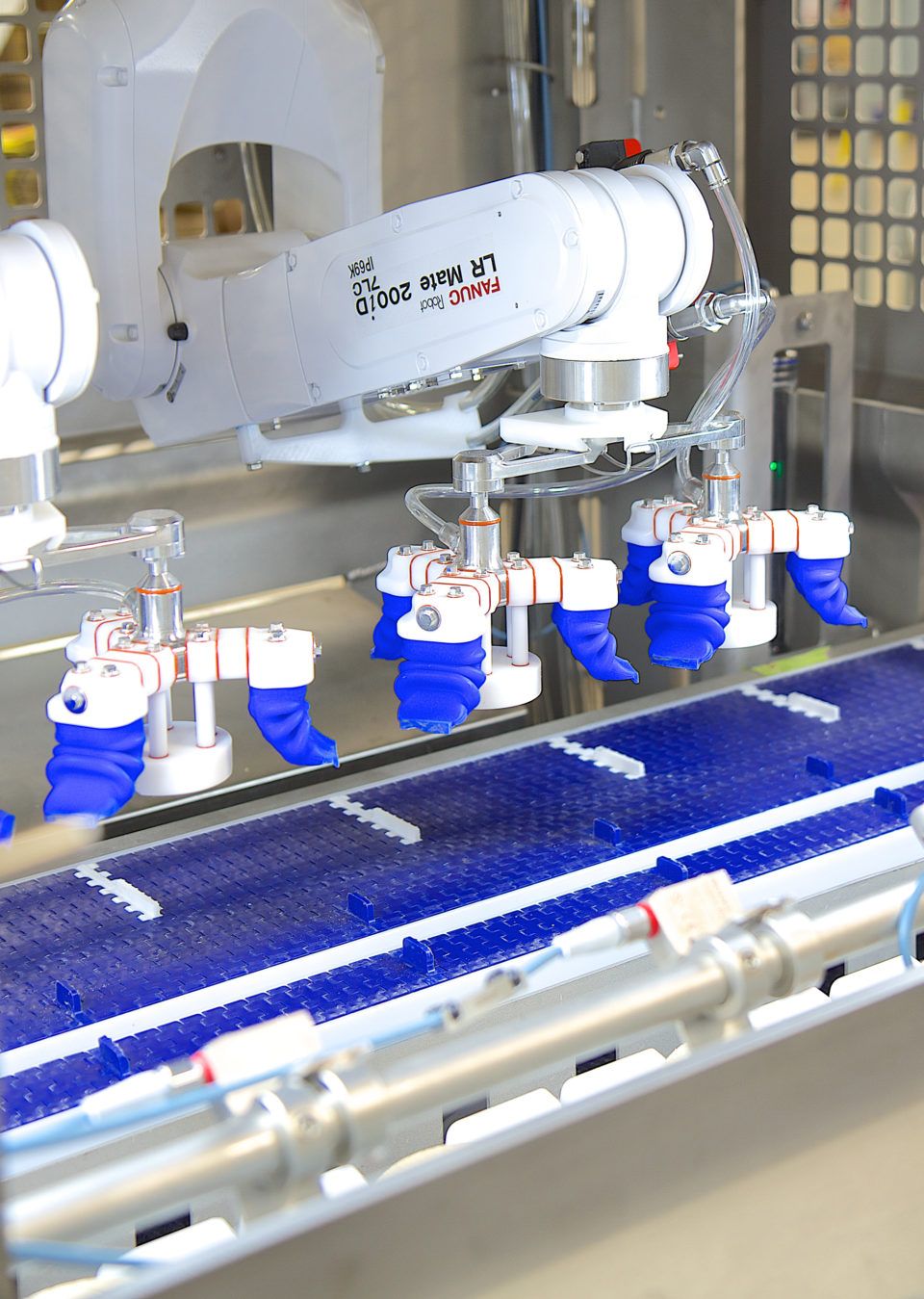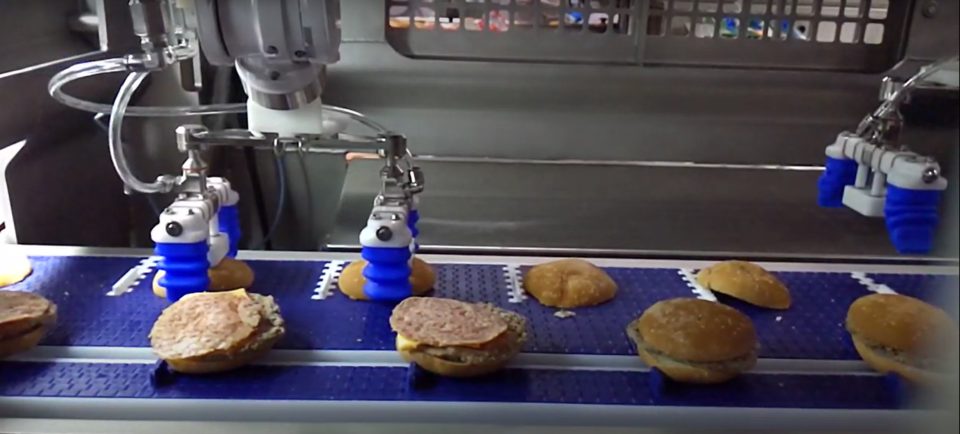
Flexible Gripper Combined with Intuitive Robotics Key to Automated Sandwich Assembly System
August 18, 2022
Flexible gripper enables first-of-a-kind (FOAK) bun management system and proof-of-concept sandwich assembly process.
Whether on the go or at home, when time is tight the sandwich is the ultimate go-to convenience. With its speed of procurement, ease of consumption, and effortless cleanup, it’s no surprise that pre-wrapped sandwich consumption is on the rise. Younger generations in particular have fueled demand across the world. The sandwich is a cost-competitive alternative to other fast foods, having many essential nutrients including protein, vitamins, and minerals.
While sales of prepackaged breakfast sandwiches may have declined during the pandemic due to lack of commuter demand, prepackaged lunch and dinner sandwiches reached a new level of prominence. Restaurant closures left few meal options other than convenience stores, supermarkets, and vending machines for essential workers on the move. Delivery drivers, along with other essential workers, could refuel their vehicles and themselves at the corner gas station without sacrificing nutrition or quality ingredients. These meals also offered the extra safety of a prepackaged sandwich free from potential human contamination.
Even now, with fewer people at the office, many on-site cafeterias have closed and transitioned to prepackaged sandwiches sold through vending machines or self-serve markets. According to a 2019 report by Grand View Research, Inc. the global prepackaged sandwich market is due to reach 18.2 billion USD by 2025, expanding at a CAGR of 4.9% over the forecast period from 2015 to 2025. However, meeting this increased demand has been difficult for prepackaged sandwich makers due to labor shortages and the Great Resignation, which have led to increased staffing issues.
Staffing Issues and Food Product Variability
Due primarily to staffing issues, one of the world’s leading prepackaged sandwich suppliers wanted to ease labor pressures on its assembly operation, scale production capacity to meet increasing demand, and improve the assembly operation. The company also wanted to use automation to help physically distance people inside the facility and minimize turnover. For example, the supplier wanted to automate repetitive tasks and assign workers more interesting and meaningful tasks elsewhere in the plant to improve employee engagement.
At the time, robotic sandwich assembly was challenging for several reasons. First, sandwich assembly often involves food products such as proteins, cheeses, and breads. The natural variations and the size and shape irregularities of food components made it difficult for machine vision systems to perceive and locate them on a conveyor for robotic pick and place. Handling them with traditional robotic grippers posed another problem.
Parallel grippers, for example, can squish and deform soft breads. And the high suction required for vacuum grippers is powerful enough to remove the breading from a chicken cutlet. Sucking up food particles makes the vacuum system a potential breeding ground for microorganisms. the frequent and regular cleaning and maintenance that would be required to sanitize the vacuum system would lead to downtime and lost revenue.
One of the biggest hurdles when it comes to automating sandwich assembly is bun management. At least that’s the contention of Ray English, commercial leader at JMP Solutions, which has recently developed a first-of-a-kind (FOAK) sandwich assembly system for this leading prepackaged sandwich supplier.
“JMP Solutions has had a long-standing relationship with this client for many years, so they asked us to look at automating bun management, protein management, and full sandwich assembly. We didn’t want to re-invent the wheel if we didn’t have to. We just wanted to solve the customers’ staffing challenges,” English explains. “We looked all over, high and low, but we weren’t able to find any existing automated bun-handling systems. So, we adapted and developed an automated bun management system with help from a number of different partners.”
Automated Bun Handling System
JMP Solution’s success with automating bun handling expanded into protein management — and a complete proof-of-concept sandwich assembly process. It all starts with bun loading and singulation. After an operator dumps the buns out of a bread sack onto a bidirectional conveyor, the buns continuously circulate until they are properly oriented and lined up. Next, the singulated buns advance onto a series of independently controlled custom smart belt segments designed by JMP Solutions. The smart belt segments provide independent speed control to properly space the buns before they enter a star-wheel mechanism. As the buns progress through the star wheel, the bun bottoms are separated and positioned on a parallel belt track. Both top and bottom bun belt tracks have regularly spaced cleats to set the process timing and registration.
The separated and registered bun halves then proceed to the protein pick-and-place cell, where a pair of FANUC LR Mate 200iD/7LC clean-room robots are equipped with mGrip™–patented elastomeric soft grippers from Soft Robotics Inc. Soft Robotics’ mGrip enables adaptive handling of unstructured objects of varying size, shape, and weight, including full-muscle proteins such as chicken breasts. The robot relies on FANUC iRVision to supply bun position coordinates to the robots, which pick proteins using the mGrip from a four-lane protein feeding system attached to the robotic cell and place one on each passing bun bottom.
The proteins are targeted by the robot based on bun availability, according to English. After placement, a machine vision system inspects to ensure that the protein was laid accurately on the bun. The topping integration cell follows and typically involves placing cheese onto the protein with an extruder. Another machine vision inspection then checks for proper sandwich assembly. The last sandwich assembly cell is the bun top pick-and-place system. This cell uses two more FANUC LR Mate 200iD/7LC clean-room robots equipped with Soft Robotics’ mGrip soft grippers to pick and place the bun tops and complete the sandwich assembly. The fully assembly and inspected sandwiches then move to a flow wrapper for packaging.
Automation Design Considerations
Many factors must be considered when designing, specifying, and implementing a robotic sandwich assembly system. According to English, two very important factors for this application were the ability to perceive and locate the food items and ensuring that a robot’s soft grippers would not damage or destroy products.
“We maintain a strong relationship with FANUC and have achieved a high level of success collaborating with the FANUC team on vision-guided robotic development, and the Soft Robotics’ mGrip fits perfectly in food-handling applications such as this,” says English. “The soft gripper has several huge advantages that really stand out in a process like this. It enables high-speed damage-free picking of delicate food product. It reduces maintenance and improves uptime compared to vacuum gripper solutions. It’s also very easy to sanitize and stands up to harsh detergents.”
With an IP69K Ingress Protection (IP) rating from the International Electrotechnical Commission (IEC), Soft Robotics grippers offer protection against dust, high temperature, and high-pressure water ingress and are safe for use in food processing where equipment must be carefully and rigorously sanitized. Used in manufacturing facilities around the world, Soft Robotics’ mGrip grippers are formed of food-grade materials. Tubular hollow elastomeric gripper fingers with flexible folds are pneumatically controlled at low pressure, allowing them to gently grasp objects.
“At JMP Solutions, we often have to build custom end-of-arm tools. Our goal, however, is always to find the best available solution for any given application, and Soft Robotics’ mGrip turned out to be ideal for making sandwiches,” says English. “It is a very effective standard tool for us. It’s highly adaptable and can be placed in either parallel or circular configurations with up to six fingers to accommodate different sized products, and it’s easy to set the amount of pressure to achieve the ideal grip strength. It’s also fast compared with mechanical alternatives.”
This particular robotic sandwich assembly cell makes 16 different sandwich types and is able to produce between 32 and 42 different S KUs for the client. Since the proof-of-concept automated sandwich assembly system was installed, the client has been able to significantly reduce labor pressures, while almost doubling production at an increased rate of 40%. “We’ve learned a lot from developing this first-of-a-kind system, and JMP Solutions always follows the continuous improvement model of plan, do, check, adjust,” says English. “For this customer, we are working to make the system applicable to a wider range of product. We’re now adapting it to handle a wider range of sandwiches made with even more delicate ingredients while working to double the speed, and Soft Robotics’ mGrip will be a part of that as well.”
KUs for the client. Since the proof-of-concept automated sandwich assembly system was installed, the client has been able to significantly reduce labor pressures, while almost doubling production at an increased rate of 40%. “We’ve learned a lot from developing this first-of-a-kind system, and JMP Solutions always follows the continuous improvement model of plan, do, check, adjust,” says English. “For this customer, we are working to make the system applicable to a wider range of product. We’re now adapting it to handle a wider range of sandwiches made with even more delicate ingredients while working to double the speed, and Soft Robotics’ mGrip will be a part of that as well.”
![]() Contact us to being your automation journey.
Contact us to being your automation journey.

